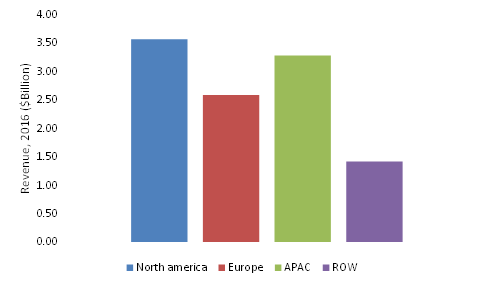Military radar market revenue to reach $14.09bn by 2024
In the report 'Military Radar Market By Type (Ground Based, Naval, Airborne, and Space Based), Industry trends, estimation & forecast, 2016 - 2024', the Global Military Radar market was valued at $10.85bn in 2016, and is projected to reach $14.09bn by 2024, growing at a CAGR of 3.4% from 2017 to 2024.
In 2016, the airborne radar segment generated the highest revenue share in the global military radar market. Among major regions, North American military radar market was the highest revenue generating market valued at $3.57bn in 2016.
Constant improvisation in Radio Frequency technology, as well as the growing need for means of early identification is driving governments across the globe to invest in the radar market. The immense need for radar as an integral part of nearly all the prominent defense equipment such as aircraft, helicopters, naval vessels, armored vehicles, as well as UAVs, is leading the military radar market to grow rapidly.
Airborne military radar segment lead the global military radar market in 2016 growing with a CAGR of 3.4% during the forecast period
The Airborne military radar segment lead the global military radar market garnering a revenue of $3.32bn in 2016. Moreover, the highest CAGR of 3.6% is also supposed to be witnessed by the same segment during the forecast period. This is because of the considerable increase in the demand for the airborne military as a result of growing risks of air strikes and penetration of terrorists. There are tremendous opportunities for the research and development in this very segment and hence innovative technical advancements will be flourishing the airborne military radar systems as an integral part of various defense systems.
North American Military radar market held more than 30% of global military radar market in 2016, growing at a CAGR of 3.3% during the forecast period
The global military radar market is geographically segmented as North America, Europe, Asia-Pacific and rest of world. Among all these regions, North America leads the market fulfilling high volume of demand for military radar. This has only been possible as a result of strong support from the government and the existence of leading vendors in the countries such as US and Canada. The US is spending considerable amounts for the R&D of radar technology.
Asia Pacific region is expected to grow with the highest CAGR of 3.6% during the forecast period
Asia-Pacific radar market earned a revenue of approx. $3.28 billion in 2016. Further, the market is expected to grow with the highest CAGR of 3.6% during the forecast period. Emerging nations such as India, China, South Korea, and Japan are anticipated to invest substantial capital for the enhancement of their respective defense systems. China and India are estimated to be the most profitable markets for military radar systems owing to growing terror activities and border disputes. In 2017, the Indian government presented a budget of $53.5bn for the defense sector.
Key findings of global military radar market
- Airborne military radar segment led the global military radar market in 2016 growing with a CAGR of 3.4% during the forecast period
- North American Military Radar market held more than 30% of global military radar market growing with a CAGR of 3.3% throughout the forecast period
- Asia Pacific region is expected to grow with the highest CAGR of 3.6% during the forecast period
- Border disputes are driving demand for the market
The report features a competitive scenario of the global military radar market, and provides comprehensive analysis of key growth strategies adopted by major players. Some of the key market players operating in the industry are Lockheed Martin, Northrop Grumman, Raytheon Company, Saab Group, Thales Group, Airbus Group, BAE Systems, General Dynamics, Israel Aerospace Industries, Finmeccanica SPA.

To find out more about the report, click here.










